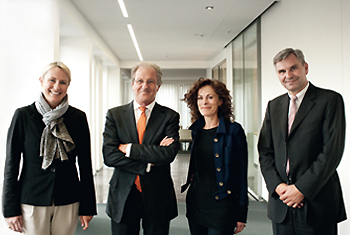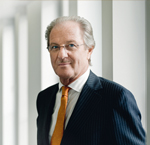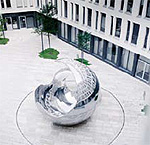Richard Murray-Bruce on a concept that can offer a host of business opportunities
“For our teams it’s not about cutting costs; it’s about improving processes.”

1
Wolfgang Reitzle, CEO of Linde Group, is not short on ambition. Having steered the former German conglomerate through the meticulously prepared acquisition of its larger UK competitor BOC, achieving global market leadership in the process, he is now out to raise the bar for performance across the organization. Talking to THE FOCUS, Reitzle explains the crucial importance of getting the right people on the right teams.
WHEN WOLFGANG REITZLE, until then a “car man” through and through, joined Linde in 2002, he found himself at the top of a pretty phlegmatic conglomerate, where each division and each subsidiary was playing a largely autonomous game to its own idiosyncratic rules. It was an approach that resulted in a progressive slide in earnings and a weak share performance, and Linde was widely considered ripe for the picking. Reitzle at once set about tightening the reins and focusing the group on its industrial gases and engineering business. As he did so, he won over the workforce through the open and timely manner in which he communicated his intentions and what he was out to achieve.
The Focus: You’ve set Linde the goal of becoming a High-Performance Organization. What does that mean in practice?
Wolfgang Reitzle: Basically it’s about creating a culture of continuous improvement across the company. I want every employee to constantly call into question everything they do in a positive and constructive way, even, or perhaps particularly, if they have ‘always done it that way’. It’s all about coming to realize that nothing is so good that it can’t be done better. So it’s pretty simple really. Although having said that, I’m well aware that, in a large company with thousands of employees, this is more a theoretical goal. But if everyone takes this idea on board, they will automatically be open for change. We can only hold our ground in the global arena with the cost structures that we have here in Germany or in major European companies in general, if our own organization is as efficient, as fast, as agile and as customer-focused in its operations as possible. Every employee must be able to see exactly how their work fits in to the bigger picture and should try to ensure that, while their goals are attainable, they do include a certain positive stretch component. So it’s also about promoting a sporting spirit of high performance at the company.
The Focus: How did put all of this into practice?
Reitzle: First you need an overview: How good are our processes – our process quality – and what does the best-in-class standard look like? Sometimes you don’t have to look too far to find that standard. You can find exemplary processes within your own organization, maybe in another country or region, where your people do the same thing differently and better. You just don’t know about it because there are no mechanisms in place to transfer best practices. In many cases, though, you can also learn from a competitor – or from a different industry. We may be a supplier of industrial gases but actually 80 percent of the costs incurred at our company during the production and sale of gases have nothing at all to do with the actual gas business. They are processes you would find at any logistics or distribution company. Gas cylinders are filled, loaded on to a truck and transported to and fro. So we need to take a careful look at how good logistics companies handle this. For many of our employees and managers, this was a whole new way of looking at things. Many of them were really surprised to discover that, in an honest comparison, we didn’t look so good after all.
The Focus: When you’d set the ball rolling, how did you sustain the momentum?
Reitzle: We went back to our managers, again and again, and made it clear to them where we have some catching up to do and what – in money terms – the difference would be worth, if we could close that gap. We worked out what our profits would look like and our share price. We looked at the options for mergers and acquisitions and how a takeover could put us in a position of strength. And we made sure our managers would participate in profits.
The Focus: Do you find that encouragement and incentives are enough to drive top performance?
Reitzle: No, which is why, at the same time, we also ran an appraisal of the strengths and weaknesses of our managers. This revealed that we didn’t have enough high potentials and talents in the pipeline. So initially, the art of successful management lay in achieving above average success with an average team.
The Focus: How can you do that? And how important is it, in this context, to ensure you have the right people on the right teams?
Reitzle: These days, in a large company nothing works properly without teams. The ideal team will not only have the people with the necessary expert knowledge on the bench to resolve the complex issues but will have the right internal team dynamics as well. You need a couple of young aggressive pioneers lined up alongside people with experience – people who are steeped in the corporate culture and know what can be done realistically and how long it will take. And the chemistry in the team has to be right.
The Focus: Can you give us an example of how that kind of team structure has paid dividends?
Reitzle: When I took over as Chairman in 2003, in four successive months we – the board – dedicated two whole days to the future strategic direction of the company. And because we knew there would be a whole lot of questions we needed to clear up, we selected ten employees to accompany us – a mixture of old and young from across the various functions. As we did so, we tried to respect the criteria I just mentioned. And that really paid dividends. They proved to be a highly motivated team, even if, as they later admitted, none of them really believed at the time that we were serious and would actually put their bold findings into practice. But it would be going too far to claim that wherever we put together a team for our High Performance Program we’ve already reached that level of perfection.
The Focus: But given your own positive experience with a well-matched team, surely you keep an eye on the way your teams are compiled, not least with a view to the High Performance Program?
Reitzle: Personally, I put my trust in the judgment and knowledge of human nature of the project managers who put together the teams. These people are generally pretty good at assessing who is good at what. And if people are honest with themselves, they will recognize how they fit in with the others. In a team, the dynamics are so intensive that it soon becomes clear to everyone who’s doing the leading and who’s just excess baggage.
Even more important though are the signals sent out by top management. You cannot, for example, claim that your company has embraced a culture of high performance and then, when it comes to promotions – the clearest sign of recognition – ignore performance metrics in favor of the old-school-tie factor. That kind of thing can have disastrous effects. For us, that was a very decisive point when we acquired BOC: We defined the values of our new company in joint teams comprising people from BOC and Linde. The guiding principle behind the integration process was to distill the best out of both worlds and flow it into a new shared culture. And we made quite a good job of it.
We had the executives from BOC and Linde assessed in line with identical criteria in a series of management appraisals, to illustrate to management and workforce that we were really looking for the best performers, and it didn’t matter if they came from Germany, India, England, France or America. The best man or woman won. We actually went so far that many BOC executives admitted they were surprised that we assigned them to top jobs. The most important thing is to apply transparent selection criteria that everyone can readily understand. Who’s going to get which job; what will the new structures look like; how does the company define itself… these are aspects that must be decided based on ultra-transparent and well communicated criteria. That was how we won the trust of the workforce.
The Focus: Which of the two original corporate cultures emerged the stronger and how did that affect the way your teams are now made up?
Reitzle: In terms of our goal of building a High Performance Organization – or HPO for short – it was very much to our advantage that both companies had very heterogeneous structures in place. Almost all of our 50,000 employees are involved in HPO, because all our core processes are being redirected and, wherever possible, standardized. That’s quite a challenge in management terms and it’s going to take a few years. But today all our teams are international in composition and spread around the world. We looked to see where a group was already mastering specific tasks particularly successfully and we made these teams our global benchmarks. So we do not have a situation in which all our team leaders are based in Munich. And distributed leadership of this kind has a positive spin-off effect in that it leads to a good balance of power across the company, where neither national organizations nor headquarters have a dominant role. I’m optimistic that the best ideas and people in objective terms will ultimately rise to the top in this kind of self-regulating process.
The Focus: After two years of growth, your new organization is now going through a tough restructuring phase. Are your original teams as successful as ever or have you had to change them?
Reitzle: There’s been no change in the mission of our teams. They’re not supposed to cut costs; they’re supposed to improve processes. The aim of HPO is not cutting costs but boosting efficiency. Revising processes automatically leads to savings for the company, and to improvements – like greater speed and productivity. It’s true, though, that we now also need to cut our costs in the short term.
The Focus: So you’re about to up the pressure on your High Performance teams?
Reitzle: Yes, of course the pressure and the requirements are rising, because right now process improvement and cost saving perhaps overlap. But the outcome of our High Performance Program is going to be a better company. Cost cuts alone would have no effect on the basic structures. That’s the difference.
The Focus: And where is the customer in all of this?
Reitzle: All of these HPO processes start with the customer. We start there and work our way back through the company. The principal goal ofHPO is customer focus.
The Focus: Where do you still see room for further growth? What new fields are emerging for your top people that might also drive motivation?
Reitzle: The nice thing about the industrial gases business is that there is an infinite number of applications, so a creative mind will always find something new. In our technology portfolio there is no shortage of areas – just think of alternative energy resources – where there is plenty of scope for an imaginative approach in future.
The Focus: What do your research and development structures look like in respect of mega-trends like alternative energies?
Reitzle: There are certain things that need to be centralized. But the vast majority of our applications engineering development work takes place in conjunction with customer engineers on site. We are currently in the process of setting up Centers of Excellence in the vicinity of key-account customers. When it comes to the use of gases in the foodstuffs sector, for example, one of our most important clients is McDonald’s. The team that develops and installs their “food applications”, as we call them, is also our lead team worldwide for this segment. It’s this team, for example, that is responsible for ensuring that a similar solution is put in place for a Chinese customer. And we apply the same principle in other industries. The vital input in terms of ideas generally comes from our people on site. They are familiar with the customer requirements and have ideas about how to make the customer’s processes even more efficient through a new application for our gases.
The Focus: On top of your own research activities, does Linde also delegate top people to work in teams outside the company?
Reitzle: Yes we do. To give you some examples, we’re working with Daimler to drive forward the development of hydrogen technology for the next generation of vehicles, and we’re collaborating with RWE to cut carbon dioxide emissions from coal-fired power plants. And those are also potential customers, of course.
The Focus: How do you deal with the so-called mavericks – those top talents you don’t want to lose but who are never going to fit comfortably into your teams?
Reitzle: We hardly have any such people, these days. But even so, we’ve set up what we call an expert career track. This way, we can pay a top-notch expert as much as, say, a manager responsible for 500 people. The appraisal criterion is not how much responsibility these people have, but how much leverage their work gives us in terms of adding value for the company. As I said, we’ve set this up now, but it’s not being taken up by the same proportion of people as in the automobile industry, for example, because we don’t manufacture a product in that sense; we deal with complex and multifaceted applications.
The Focus: Have you now completed the integration of Linde and BOC?
Reitzle: That’s a definite yes! We had achieved the synergies that we were out to exploit by the end of 2008 and that also marked the completion of the cultural integration process. It ran like clockwork and now it’s over and done with. Then we decided to make use of the momentum that we’d built up, to drive the creation of our High Performance Organization. That will carry us forward for the next few years. The moment we’ve established the HPO we will kick off our third wave and carve out a distinctive profile for ourselves. We can already imagine that, ten years from now, Linde will look quite different.
The Focus: How do you imagine the company looking and how are you going to get there?
Reitzle: We’re aiming to add sales and earnings potential to our portfolio through innovation, applications engineering and the targeted acquisition of several firms that are not directly involved in the gases sector as such, in a move designed to set us apart from our main competitors. All gas producers turn out oxygen, hydrogen and nitrogen. There’s no difference between the molecules that we sell. We can’t design a new look for hydrogen. The decisive USP can only lie in innovation and applications engineering. Our engineering sector is already providing us with a certain competitive edge, offering skills that others can’t match. With our roots as a classical German engineering company, this kind of thing is in our blood and of course we’re out to convert it into earnings. On top of which, we never had that one-dimensional focus on shareholder value. I think we’ve struck a pretty good balance between our entrepreneurial goals, the interests of our employees, and our responsibility towards the locations, the communities, where we operate.
The Focus: Wolfgang Reitzle, thank you for talking with us.

The interview with Wolfgang Reitzle was conducted by (from l.) Gabriele Röhrl, Egon Zehnder, Munich, Ulrike Mertens, THE FOCUS, and Jörg Ritter, Egon Zehnder International, Berlin.
RESUMÉ Wolfgang Reitzle

Wolfgang Reitzle was born in 1949 and grew up in Ulm, Germany. He studied Economics and Engineering in Munich. After obtaining his doctorate, in 1976 he began his career with BMW, where under the aegis of the Chairman of the day, Eberhard von Kuenheim, he played a decisive role in the developments that transformed what had long been a relatively small automaker and motorcycle manufacturer into a global brand, renowned for its performance luxury cars. From simple beginnings as a specialist for manufacturing technology, Reitzle climbed the career ladder of the typical car executive at record speed. From 1983 onwards he held interim responsibility for research and development and in 1986 was appointed a Deputy Board Member. One year later, he was made Executive Board Member responsible for Research & Development and from then on was widely expected to succeed von Kuenheim as Chairman. After the company twice passed him over in favor of another top manager, however, Reitzle moved to Ford Motor Co. as Group Vice President for Ford's premium brands. Three years later, he opted for a change of industry and joined capital goods manufacturer Linde AG as Member of the Executive Board with responsibility for Corporate Development and Technology. Six months later he was appointed Chairman. In 2006 he was voted "Manager of the Year". Wolfgang Reitzle is married to TV presenter Nina Ruge, and since Linde relocated its headquarters in 2007 he has taken up residence in Munich again. He loves skiing and is an accomplished golfer.
LINDE AG A cool coup

Linde AG was founded by the inventor and entrepreneur Carl von Linde. This gifted engineer and refrigeration specialist laid many of the key foundations for modern refrigeration technology. Established in 1879, Linde soon became Europe's leading name in refrigeration. In 1895, von Linde first presented a process for the liquefaction of air by means of compression; a process that opened the door to the production of industrial gases. At the same time, von Linde diversified operations and began manufacturing engines in a move that would ultimately lead to the production of forklift trucks and the establishment of Linde's Material Handling division.
In 2003, as new Chairman of the Board, Wolfgang Reitzle prescribed a comprehensive facelift for the entire conglomerate, aiming to refocus operations on the Gases and Engineering divisions. The Refrigeration division was spun off and sold, as, at a later stage, was the Material Handling division (forklifts and logistics). In 2006, Linde acquired the British industrial gases company BOC, in a deal that made it the world's leading supplier of industrial gases. In 2008, with almost 52,000 employees, Linde AG posted net earnings of EUR 717 million on sales of EUR 12.66 billion. In the first nine months of the current financial year, sales and earnings were down but the operating margin improved despite the difficult market environment.
PHOTOS: RÜDIGER NEHMZOW





